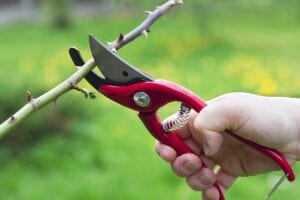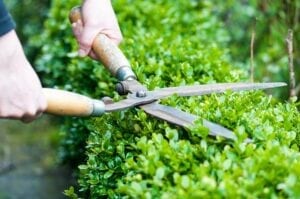
What is Pruning?
Pruning is the practice of selectively removing plant parts (branches, buds, spent flowers, etc.) to manipulate the plant for landscape purposes
Why Prune?
More important than knowing when or how to prune is understanding what you are trying to achieve.
Some common reasons to prune include:
- To accentuate an ornamental feature (flowers, fruit, etc.)
- To control size.
- To maintain plant health. a. Always cut out dead, dying, diseased or damaged wood. b. Remove crossing or rubbing branches. c. Maintain good air circulation within the plants framework. d. Remove unwanted shoots.
- Maintain a desired shape. Know the plant and its natural shape, trying to fight it will lead to undesirable results. Allow the plant to get a little bigger each year. Only trim half to two-thirds of the new growth.
Pruning Techniques
Depending on the plant type and desired effects, routine pruning is necessary in order to optimize the plant’s ornamental features. The following methods outline routine pruning techniques: 1.
- Method 1: Trimming A light pruning to maintain shape or size between late winter and late summer. Deadheading flowering plants encourages the production of more blooms.
- Method 2: Annual Hard Pruning Cutting back to a short framework. This is best for deciduous shrubs where the current season’s growth offers the best ornamental feature. Typically done in late winter or early spring.
- Method 3: Rejuvenation or Thinning Annually cut away one third of the oldest branches to keep the plant younger and stronger and to maintain good air circulation. This should occur in late winter/early spring or just after bloom for spring blooming plants.
 Basic Tools for Pruning
Basic Tools for Pruning
For most pruning projects you will need pruning shears, loppers, or a small pruning saw. Hicks Nurseries carries a great selection of tools for all of your pruning needs.
When to Prune
The right time to prune depends on the type of plant, the desired outcome and the severity of the pruning. Pruning to remove broken, dead or diseased parts can be done at any time of year. Most trees and shrubs, especially those that flower on current season’s new growth, should be pruned in late winter or early spring before the onset of new growth. (March-April). Plants that bloom on previous season’s wood such as fruit trees, rhododendrons, azaleas and lilacs should be pruned immediately after blooming to maximize the next year’s flowering.
*A special note about when to prune Hydrangea: Hydrangea macrophylla (such as Endless Summer). Since they produce flowers on the previous season’s growth, pruning hard typically results in no flowers. Selectively thin in early spring just before bud break in order to control size. Hydrangea arborescens (such as Annabelle) and Hydrangea paniculata (such as Tardiva) both produce flowers on the current season’s growth and respond well to both hard or light pruning. Prune in late winter/early spring before new growth appears. Hydrangea quercifolia (Oakleaf Hydrangea) The flowers are produced on the previous season’s growth. Prune right after flowering (mid-summer) to control size and shape. Only remove up to 1/3 of the plant.
This list provides a basic time frame of when to prune commonly used plants. For additional information, please speak with one of our sales associates.
February-April
Summer flowering shrubs such as butterfly bush, hydrangea*, crape myrtle, roses, spirea and privet should be pruned before bud break in the spring. Now is also the time to prune fruit trees and evergreens such as arborvitae, holly, boxwood, juniper and yew.
May-June
Prune most spring flowering trees and shrubs right after they flower. This includes andromeda, azalea, forsythia, rhododendron, lilacs, dogwoods, flowering cherry and plum trees and some hydrangea varieties.*
June-July
This is the preferred time to thin most deciduous trees such as birch, linden, maples, flowering cherry and plums, spruces and honey locust. Prune hedges as needed to maintain shape.
August-December
Heavy pruning at this time could result in the stimulation of new growth that may not have enough time to mature before winter; making it prone to frost damage. Limit pruning to the removal of dead or damaged branches only during this time.
Additional Information:
Pruning Tips
Caring for Hydrangea
